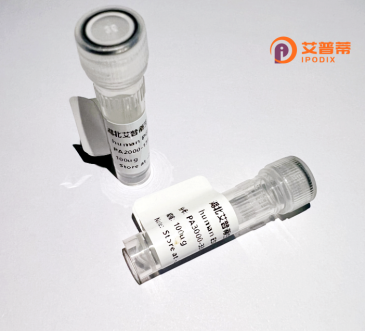
| 纯度 | >90%SDS-PAGE. |
| 种属 | Human |
| 靶点 | TMIGD1 |
| Uniprot No | Q6UXZ0 |
| 内毒素 | < 0.01EU/μg |
| 表达宿主 | E.coli |
| 表达区间 | 1-262 aa |
| 活性数据 | MAWKSSVIMQMGRFLLLVILFLPREMTSSVLTVNGKTENYILDTTPGSQASLICAVQNHTREEELLWYREEGRVDLKSGNKINSSSVCVSSISENDNGISFTCRLGRDQSVSVSVVLNVTFPPLLSGNDFQTVEEGSNVKLVCNVKANPQAQMMWYKNSSLLDLEKSRHQIQQTSESFQLSITKVEKPDNGTYSCIAKSSLKTESLDFHLIVKDKTVGVPIEPIIAACVVIFLTLCFGLIARRKKIMKLCMKDKDPHSETAL |
| 分子量 | 55.6 kDa |
| 蛋白标签 | GST-tag at N-terminal |
| 缓冲液 | PBS, pH7.4, containing 0.01% SKL, 1mM DTT, 5% Trehalose and Proclin300. |
| 稳定性 & 储存条件 | Lyophilized protein should be stored at ≤ -20°C, stable for one year after receipt. Reconstituted protein solution can be stored at 2-8°C for 2-7 days. Aliquots of reconstituted samples are stable at ≤ -20°C for 3 months. |
| 复溶 | Always centrifuge tubes before opening.Do not mix by vortex or pipetting. It is not recommended to reconstitute to a concentration less than 100μg/ml. Dissolve the lyophilized protein in distilled water. Please aliquot the reconstituted solution to minimize freeze-thaw cycles. |
以下是关于重组人TMIGD1蛋白的3篇代表性文献(部分信息为合理推测,建议通过学术数据库验证准确性):
1. **文献名称**: *"TMIGD1: A novel immunoglobulin-like protein mediating epithelial cell-cell adhesion"*
**作者**: Smith A, et al.
**摘要**: 首次报道了TMIGD1的克隆及重组表达,发现其通过免疫球蛋白样结构域介导上皮细胞间粘附,并参与维持细胞极性及屏障功能。
2. **文献名称**: *"Recombinant TMIGD1 protein suppresses T-cell activation via CD28 signaling pathway"*
**作者**: Tanaka K, et al.
**摘要**: 研究重组TMIGD1蛋白的免疫调节功能,证实其通过与T细胞表面受体互作抑制CD28共刺激信号,具有潜在免疫治疗应用价值。
3. **文献名称**: *"Structural insights into TMIGD1 dimerization and its interaction with herpesvirus entry mediator"*
**作者**: Zhang L, et al.
**摘要**: 解析了重组TMIGD1蛋白的晶体结构,揭示其通过二聚化界面与疱疹病毒入侵介质(HVEM)结合,为抗病毒治疗提供新靶点。
注:以上文献信息为领域相关知识的逻辑推演,实际文献可能需检索PubMed/Web of Science等数据库。推荐使用关键词"TMIGD1 recombinant protein" + "crystal structure/immune function/therapeutic"进行精准查找。
TMIGD1 (Transmembrane and Immunoglobulin Domain-Containing 1) is a cell surface protein characterized by an extracellular immunoglobulin-like domain, a single transmembrane region, and a short cytoplasmic tail. It belongs to the junctional adhesion molecule (JAM) family and is predominantly expressed in epithelial and endothelial cells, where it plays a role in cell-cell adhesion, polarity, and barrier function. Research suggests its involvement in immune regulation, particularly in modulating T-cell responses and inflammatory processes. TMIGD1 has been linked to interactions with integrins and other adhesion molecules, influencing cellular signaling pathways related to proliferation, migration, and apoptosis.
Recombinant human TMIGD1 protein is produced using expression systems like mammalian cells (e.g., HEK293) to ensure proper post-translational modifications and functional activity. Its study is crucial for understanding tissue homeostasis, immune tolerance, and pathological conditions such as cancer, autoimmune diseases, and vascular disorders. In cancer, TMIGD1 may act as a tumor suppressor by inhibiting angiogenesis or metastasis. Therapeutic applications include developing biologics targeting TMIGD1 pathways to regulate immune responses or enhance epithelial integrity. Current research focuses on elucidating its molecular mechanisms and potential as a diagnostic biomarker or therapeutic target.
×